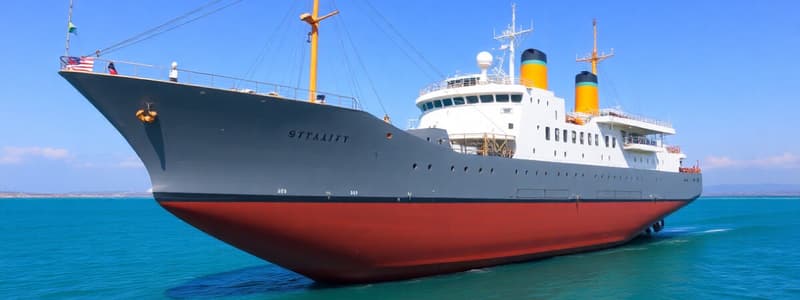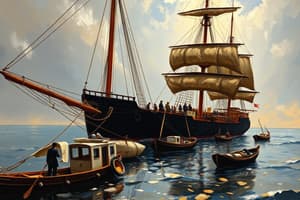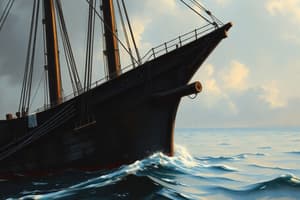Podcast
Questions and Answers
What is the significance of understanding ship stability?
What is the significance of understanding ship stability?
- Maintaining an upright position and returning to equilibrium after being disturbed. (correct)
- Ensuring comfortable passenger experience.
- Enhancing the aesthetic appeal of the vessel.
- Optimizing fuel consumption during voyages.
Which of the following correctly defines the 'Center of Buoyancy'?
Which of the following correctly defines the 'Center of Buoyancy'?
- The horizontal distance between the lines of action of the buoyancy force and the weight force when the ship is inclined.
- The point where the vertical line of action of the buoyancy force intersects the ship's centerline when the ship is slightly inclined.
- The point where the entire weight of the ship is considered concentrated.
- The point where the upward force of buoyancy is concentrated; equal to the weight of water displaced. (correct)
What does a larger Metacentric Height (GM) indicate about a ship's stability?
What does a larger Metacentric Height (GM) indicate about a ship's stability?
- Reduced initial stability.
- Higher risk of capsizing.
- Greater initial stability. (correct)
- Increased susceptibility to listing.
What is the primary concern addressed by Damage Stability?
What is the primary concern addressed by Damage Stability?
How do liquids in partially filled tanks aboard a ship affect its stability?
How do liquids in partially filled tanks aboard a ship affect its stability?
What is the definition of 'Heel' in the context of ship stability?
What is the definition of 'Heel' in the context of ship stability?
What is the main purpose of a ship's ballast system?
What is the main purpose of a ship's ballast system?
How does the distribution and weight of cargo affect a ship's stability?
How does the distribution and weight of cargo affect a ship's stability?
What does 'Ship stress' refer to?
What does 'Ship stress' refer to?
Which type of stress pulls or stretches the material?
Which type of stress pulls or stretches the material?
What is 'Deadweight' in the context of ship measurements?
What is 'Deadweight' in the context of ship measurements?
What is the effect of carrying heavy cargo like iron ore on a ship's deadweight capacity?
What is the effect of carrying heavy cargo like iron ore on a ship's deadweight capacity?
What principles are encompassed by 'Ship hydrostatics'?
What principles are encompassed by 'Ship hydrostatics'?
What is the ‘Forward Perpendicular’ (FP)?
What is the ‘Forward Perpendicular’ (FP)?
What is the Length Overall (LOA)?
What is the Length Overall (LOA)?
What is the purpose of the bilge system on a ship?
What is the purpose of the bilge system on a ship?
What is the focus of the stability calculations?
What is the focus of the stability calculations?
What does the Loading Control System software help to calculate?
What does the Loading Control System software help to calculate?
What factors are considered when estimating a damaged vessel's trim and stability?
What factors are considered when estimating a damaged vessel's trim and stability?
What consideration is essential when loading weight to maintain a constant after draft?
What consideration is essential when loading weight to maintain a constant after draft?
Flashcards
Ship Stability
Ship Stability
Ability to maintain an upright position and return to equilibrium after being disturbed.
Center of Gravity (G)
Center of Gravity (G)
The point where the entire weight of the ship is considered concentrated.
Center of Buoyancy (B)
Center of Buoyancy (B)
Point where upward buoyancy force equals the weight of displaced water, concentrated.
Metacentric Height (GM)
Metacentric Height (GM)
Signup and view all the flashcards
Righting Arm (GZ)
Righting Arm (GZ)
Signup and view all the flashcards
Righting Moment
Righting Moment
Signup and view all the flashcards
Damage Stability
Damage Stability
Signup and view all the flashcards
Intact Stability
Intact Stability
Signup and view all the flashcards
Dynamical Stability
Dynamical Stability
Signup and view all the flashcards
Heel
Heel
Signup and view all the flashcards
List
List
Signup and view all the flashcards
Free Surface Effect
Free Surface Effect
Signup and view all the flashcards
Trim
Trim
Signup and view all the flashcards
Equilibrium
Equilibrium
Signup and view all the flashcards
Ship Stress
Ship Stress
Signup and view all the flashcards
Tensile Stress
Tensile Stress
Signup and view all the flashcards
Compressive Stress
Compressive Stress
Signup and view all the flashcards
Deadweight
Deadweight
Signup and view all the flashcards
Length Between Perpendiculars (LBP)
Length Between Perpendiculars (LBP)
Signup and view all the flashcards
Ship Hydrostatics
Ship Hydrostatics
Signup and view all the flashcards
Study Notes
- Ship stability is the vessel's ability to stay upright and return to equilibrium after disturbances from external forces.
- Understanding stability is crucial for safe navigation and preventing capsizing.
Fundamental Concepts
- Center of Gravity (G): The point where the ship's entire weight is concentrated.
- Center of Buoyancy (B): The point where the upward buoyancy force (equal to the weight of displaced water) is concentrated.
- Metacenter (M): The intersection point of the buoyancy force's vertical line of action with the ship's centerline when slightly inclined.
- Righting Arm (GZ): The horizontal distance between the lines of action of buoyancy and weight forces, indicating the restoring force.
- Metacentric Height (GM): The vertical distance between G and M, a key indicator of initial stability; a larger GM means greater stability.
- Righting Moment: The product of the ship's weight and the righting arm (GZ).
- Damage Stability: The ship's stability after sustaining hull breach and flooding.
- Statical Stability: Ship stability when water level is calm and ship is inclined.
- Dynamical Stability: Ship stability with dynamic water level (waves) and inclination.
- Free Surface Effect: Liquids in partially filled tanks create a virtual rise in G, reducing stability. Wind and Waves: External forces exerted on the ship influence stability.
- Trim: Difference in draft between the bow and stern.
- Equilibrium: State where the ship is at rest, G and B are vertically aligned.
- Heel: Transverse inclination caused by external forces.
- List: Transverse inclination due to uneven weight distribution.
Types of Stability
- Intact Stability: Stability when the ship is undamaged and operating normally.
Factors Affecting Stability
- Loading: Cargo, passenger, and equipment weight and distribution affect G and stability.
Ship Stress
- Ship stress refers to the internal forces within the ship's structure due to external loads.
- External Loads: Waves, cargo, and engine thrust can affect the internal forces.
- Understanding stress is crucial for structural integrity and preventing failure.
- Tensile Stress: pulls or stretches the material.
- Compressive Stress: Pushes or compresses the material
- Shear Stress: Acts parallel to the surface, causes sliding or deformation
- Bending Stress: Occurs when a material is subjected to a bending force, causing it to deform.
- Torsion Stress: Occurs when a material is subjected to a twisting force causing it to deform
Ship Dimensions
- Air draft is the distance from the waterline to the highest point of the vessel.
- Deadweight: The maximum weight a vessel can carry, including cargo, fuel, provisions, and crew, without compromising its structural integrity.
Ship Tonnage
- Gross Tonnage: Measures total internal volume.
- Net Tonnage: Measures cargo space volume.
- Lightweight Tonnage: Weight of the ship itself.
- Deadweight Tonnage: Weight of cargo, fuel, supplies, crew, etc.
Deadweight and Cargo Capacity
- Deadweight is not just the maximum weight a ship can carry.
- Deadweight also depends on cargo type and stability requirements.
- Heavy cargo (iron ore) results in lower deadweight capacity than lighter cargo.
- Deadweight calculation: Displacement loaded minus displacement light provides lifting capacity.
Ship Hydrostatics
- Ship hydrostatics deals with forces on a floating ship.
- Deals with buoyancy, stability, and trim for safe/efficient operation.
- Forward Perpendicular (FP): Vertical line at the intersection of the designed load waterline and the forward face of the stem.
- After Perpendicular (AP): Perpendicular to the waterline at the after side of the rudder post/center line of the rudder stock.(if no rudder post).
- Length overall (LOA): The maximum length from the forward most point to the after most point.
- KEEL (K): The lowermost point of the ship at any point along its length.
- Length between perpendiculars (LPP or LBP): Longitudinal distance between the forward and aft perpendiculars.
- Length of waterline (LWL): Hull length intersecting the water surface.
Bilge system
- Bilge system removes water/fluids from the lowermost areas.
- Fluids such as leaks, condensation, washing, or firefighting efforts.
Stability
- Ship stability deals with how a ship behaves at sea.
- Applies to calm water and waves, intact or damaged stability.
- Stability calculations focus on gravity, buoyancy, and metacenters.
Ballast System
- The ballast system controls stability by adjusting draft and trim.
- It involves filling or emptying ballast tanks with seawater to achieve the desired buoyancy and prevent the ship from becoming unstable.
Stability Instruments
- Loading Control System software calculates loading, trim, and stability.
- Can be used for intact or damaged vessels.
- Aims to adjust loading for required trim, stability, and strength.
- Aims to estimate damaged stability by indicating types of flooding.
Studying That Suits You
Use AI to generate personalized quizzes and flashcards to suit your learning preferences.




